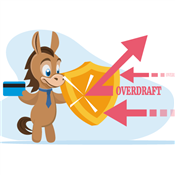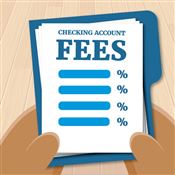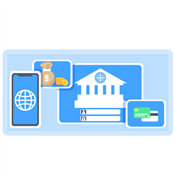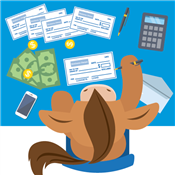How to Avoid Overdraft Fees
Overdraft fees are your account's worst enemy. Find out how to avoid overdraft fees once and for all, and one common mistake to avoid at the bank.
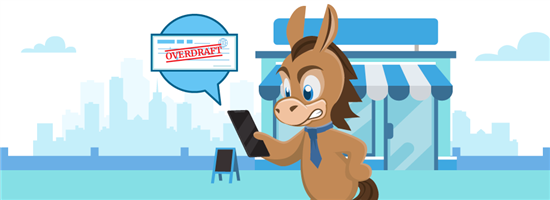 |
Everyone's been overdrawn at least once. But there are ways to avoid these sneaky charges.
Discover 7 steps for avoiding overdraft fees forever in this guide. Plus, find out how long you have before extended overdraft kicks in and what popular banks charge for overdraft.
What is an Overdraft Fee?
An overdraft fee is a charge for spending more money than your checking account has in it. If you write a check, swipe your debit card, or withdraw cash at an ATM and you don't have the money to cover it, the bank charges a fee if the transaction goes through.
According to the FDIC, in 2017, banks with over $1 million in assets collected almost $11.5 billion in overdraft or non-sufficient funds fees.
If you've contributed to this massive number, it's time to learn how to avoid overdraft fees.
How to Avoid Overdraft Fees
At $35 per occurrence (plus an extra fee per day if you wait too long), overdraft fees are a budget's worst enemy. Here are the best ways to avoid overdraft fees.
1. Opt Out of Overdraft Coverage
Overdraft coverage seems tempting, but it's a trap. Do you want the bank approving purchases you don't have the money to cover?
If you opt-out of overdraft coverage, your transactions won't go through. Hearing that your transaction was declined may be embarrassing - we get it. But you'll save money on bank fees and won't have to make up the difference.
Overdraft coverage is an invitation to overspend - don't accept it.
2. Set up Alerts for Low Balances
 |
Try setting up account alerts with your bank. You set the threshold (could be anywhere from $500 to $20), choose your preferred contact method (email or text), and the bank alerts you when your balance is below that limit.
Checking your account balance regularly is important, but setting up alerts is the "backup" to give you peace of mind.
- Chase: $34
- Bank of America: $35
- Wells Fargo: $35
- US Bank: $36
- TD Bank: $35
- Ally: $25
- Capital One: $35
3. Watch Your Account Balances Regularly
It's ideal to check your account balance daily. Simply log in to your bank's mobile app (or via desktop) and make it part of your daily routine.
This way you'll know your balance and what you can or can't spend. Watching your account balances also helps you stay within your budget, which is the key to healthy personal finances.
You can't reach your savings or personal financial goals if you don't know where you stand.
4. Link Another Account
Some banks allow you to link a savings account or credit card to your checking account. If you go over your balance, they'll transfer the funds from your savings account or charge your credit card.
This method isn't free, so don't use it often. Most banks charge a service fee for the transfer to your checking account. Also, if you link a credit card, you'll incur interest charges if you don't pay the balance in full right away.
5. Keep a "Cushion Balance"
Set a personal limit to act as a cushion balance, a.k.a money you don't spend. For example, if your cushion balance is $100, you'll treat it like you have $0.
If you overspend, you know you have the cushion to protect you. That's not an invitation to overspend, but it's peace of mind knowing you have the money should you go over your "cushion."
A cushion balance is also handy for covering automatic payments you may have forgotten about or bank fees you didn't realize you owed.
6. Use an Account That Doesn't Charge You
Not all banks charge overdraft fees. If you regularly struggle with overdrafting and are in the market for a new account, it's best to choose an account that won't charge you. Our round-up of the best free checking accounts is a good place to start.
Remember: Choose the account that will cost you the least amount of money and keep you on budget, rather than allowing you to overdraft.
7. Get a Prepaid Debit Card
If you can't stop yourself from going over your balance, use a prepaid debit card. You can make deposits and withdrawals just like a checking account, but it's not linked to a bank account.
When you spend the funds, they're gone. The bank may charge a small fee for a declined transaction, though, so read the fine print before you take a chance.
How to Get Overdraft Fees Waived
If you made a mistake and have an overdraft fee, don't give up hope. You may be able to get it waived. (And it can't hurt to ask.)
Call the Bank and Ask
 |
The simplest way to get overdraft fees waived is to call the bank. Before you call, create your script. Introduce yourself and say that you went over your account limit and would like to see how you could get the fee waived.
Talk about how long you've been a customer (if you're a longstanding customer), your previous banking history (if it's good), and why you went over your limit, especially if it was a one-time mistake or something tragic occurred.
Be prepared for them to say "no," but at least you asked. If you find yourself asking too many times, it's time to revamp your budget and/or change bank accounts.
Try a Negotiation App
Several apps negotiate fees on your behalf. You give them access to your account, and they'll try to get the fees waived or reduced for you. TrueBill and Trim are two great examples.
They help you manage subscriptions, lower bills, and get fees refunded. They charge a percentage of the savings they earned you, usually 33% - 40% of the savings.
Bottom Line
It's never a good habit to pay overdraft fees. As an emergency, it's okay, and hopefully, it's a one-time deal that the bank may even waive.
If it becomes a habit, though, it's essential to set up safeguards so it doesn't happen again. Whether you cut back on spending, change bank accounts, or set up a cushion, figure out what will keep you from going over your limit.
Write to Sam Hawrylack at feedback@creditdonkey.com. Follow us on Twitter and Facebook for our latest posts.
|
|
| ||||||
|
|
|
